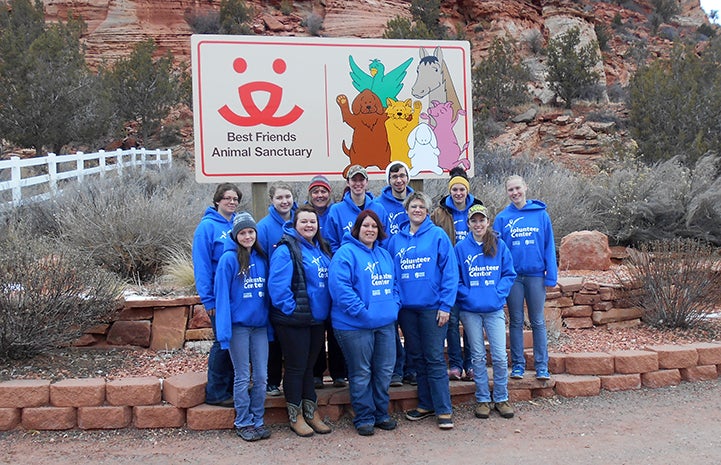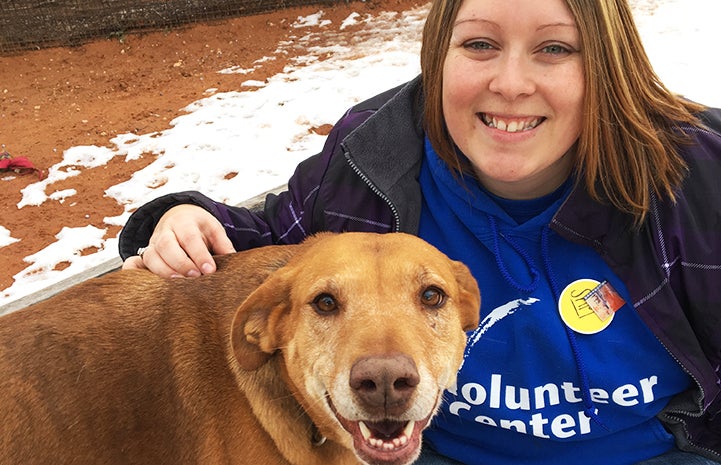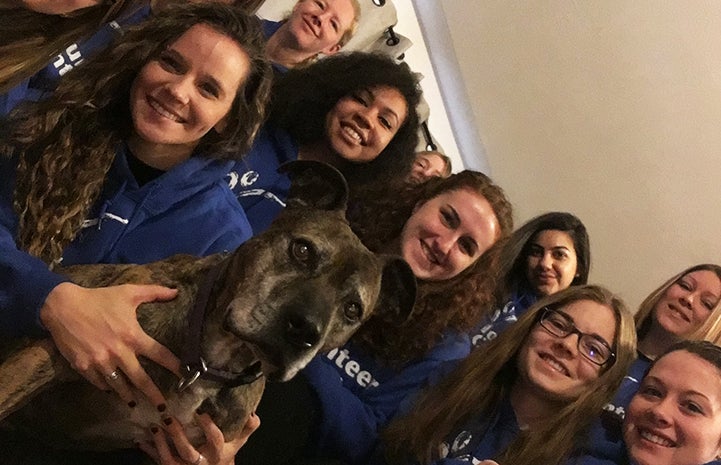Service-learning with animals

On a cold, blustery day at the Sanctuary, 11 veterinary technician students gathered with their faculty leader in one of the Cat World buildings and got to work cleaning rooms, socializing cats and getting some great inspiration for their future careers.
The students, who’d traveled from Madison Area Technical College in Wisconsin, had happily passed up the chance to catch up on some much-needed rest on their winter break, or to escape the cold. Instead, they chose to spend a chilly, busy week volunteering at the Sanctuary and learning about Best Friends’ work in the no-kill movement.

Service-learning trips to the Sanctuary
Madison Area Technical College has been sending students on service-learning trips to the Sanctuary since 2014. The idea originally came from a student who wanted to travel to Best Friends with a group of like-minded peers. When the student approached Dr. Clarissa Sheldon, a veterinarian and full-time faculty member at the college, Dr. Sheldon said, “Let’s get it set up.” And they did.
The rest was history. Dr. Sheldon has taken groups of 11 students to Best Friends every year since. “I firmly believe in service learning as a way to build skill, confidence and a sense of purpose in the veterinary technician students,” she says.
Find out about group and family trips to the Sanctuary
The next wave of animal advocates
There’s more. Dr. Sheldon says she wants her students to “realize the importance of each individual animal life.” She knows that these students aren’t just the new wave of vet techs. “Our adventures to Best Friends help bring in the next wave of animal advocates,” she says.
While they learn about the no-kill movement and lend their emerging skills to it, the students are also on a journey of self-discovery. They are learning how they can help to end the killing of shelter pets across the country and how to make life better for every animal they encounter.
Community service hours for vet techs
The students are preparing for busy careers as licensed veterinary technicians. In order to earn their vet tech certification after graduating the vet tech program, they’ll have to sit for a national exam to become licensed in their state. So they know a thing or two about hard work and planning ahead. At Madison Area Technical College, they are required to do 10 community service hours each semester. But many of them go far above and beyond, logging up to 40 hours of volunteer work a semester with local humane societies and programs that help community cats.
While at the Sanctuary, the group toured Parrot Garden, Wild Friends, and spent time working in Dogtown and Cat World. They cleaned dog rooms and scrubbed the whole puppy preschool building from top to bottom. They helped to fold laundry, scoop litter boxes, mop floors and organize shelves and closets. They watched a presentation to learn about the heartbreaking effects of dog breed discrimination and how they can help prevent or reverse it in their own communities.
In between all their hard work, the students also had a chance to help socialize puppies, cuddle with some friendly cats and take a few dogs on some quintessential southern Utah outings to places like Zion National Park and Coral Pink Sand Dunes State Park.

Inspiring vet tech volunteer opportunities
The volunteer experience was exciting and exhausting, but, most import of all, the students found it inspiring. One student, Aisha Hill, said she wanted to come to the Sanctuary because “Best Friends seems to have a good purpose, and I’m learning a lot. I’m big on no-kill, and I like that (Best Friends) keeps the animals no matter how long it takes them to find homes. There’s a nice set-up in the dog and cat rooms, and caregivers make the animals feel loved. There’s a nice, homey feeling here.”
Another student, Dani Van Den Voogaard, is looking for a job in animal welfare and decided to use her winter break to come check out the Sanctuary. “I don’t want to leave,” she said. “It would be nice to have more places like Best Friends. There’s nothing like this in Wisconsin.”
“It's been interesting to hear some of the stories about what (Best Friends) will do for animals medically — what the organization is willing to do for these animals and invest in them,” says a third student, Kat Lund.
“The work that everyone does there is amazing,” Breanna Scott chimed in. “It was also fantastic to meet both employees and volunteers. Everyone always seemed happy to be there and very passionate about the work that they are doing. I loved the experience.”

No-kill career paths
If the past is any indication, this service-learning experience isn’t one the students are likely to forget. It may even change some of their career paths. Since Madison Area Technical College students began coming to the Sanctuary, one alumnus now manages her local humane society. Countless others volunteer at, or advocate for local community cat events. And one graduate, Andrea Kent, works for Best Friends as a vet tech.
When she started the vet tech program in the fall of 2013, Andrea hadn't heard of Best Friends. But the service-learning trip sounded like something right up her alley so she came along. She loved it so much she returned to the Sanctuary the following year. During that second visit, she decided to apply for a vet tech position. “I moved to Kanab in September of 2015 and am already past the year and a half mark at Best Friends,” Andrea says.
Of course, not all vet tech students will become animal advocates or work for no-kill organizations; however, because of their experiences at the Sanctuary, even those who don't will have a greater appreciation of Best Friends’ work and how they can help improve animals’ lives and promote no-kill through their profession.
Sometimes, all of that starts by taking care of some grateful cats on a cold winter day.

Photos courtesy of Samantha Hunter